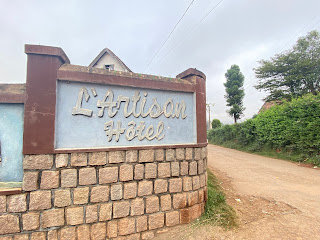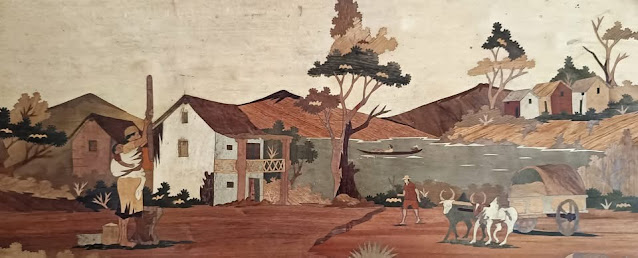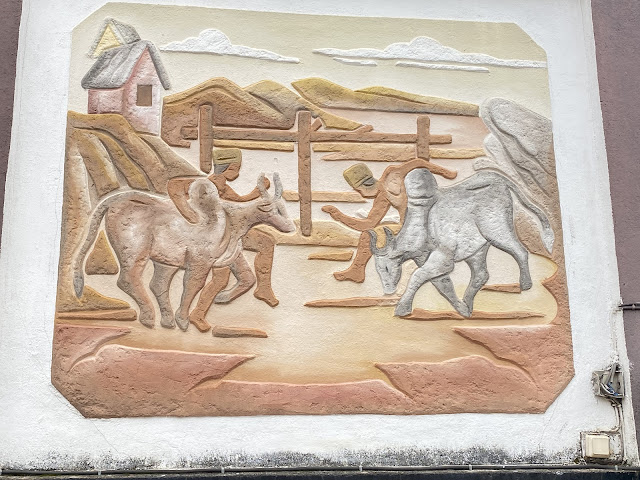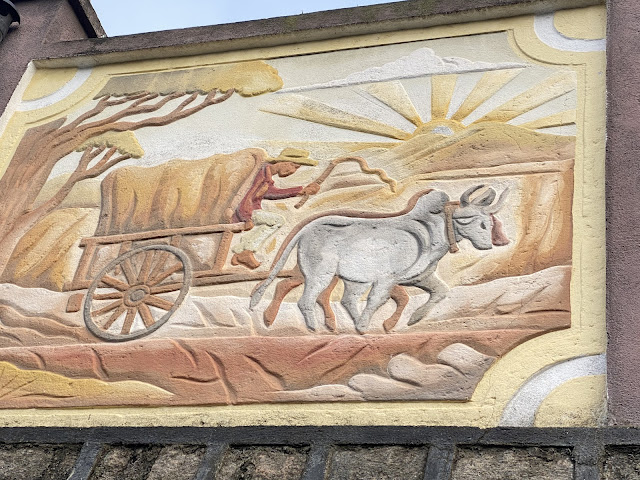DAY8 Madagascar
Road trip🇲🇬
17/05/2025 - Ambositra - Antananarivo via Antsirabe
Trip plan : 260 km - about 7h drive : End of the road trip! Ambositra is the capital of handcraft in Madagascar - you will visit some shops and workshops in the morning : this place is famous for Zafimaniry woodcarving, it is classified UNESCO World heritage - Drive back to Antananarivo after the visit - Lunch at leisure - Arrival in the evening and installation at your hotel - Dinner and overnight
Ambositra (pronounced 'Ambushed') is a city in Madagascar, renowned for its traditional decorative paper-making.
Ambositra is the capital of the Amoron'i Mania region, and of Ambositra District. It is the centre of Madagascar's wood-carving industry due to the presence of the Zafimaniry tribe, a subgroup of the Betsileo tribe. There are many shops selling wooden boxes, chessboards and figurines.
Even the hotel we stayed in had a very artistic atmosphere. The rooms were decorated with wood, the furniture was also made of wood, and even the fence around it had bas-reliefs that told the story of the history and way of life of the people on this island very clearly and beautifully.

The Sivy board consists of lines and intersections that create a grid with 5 rows and 9 columns subdivided diagonally to form part of the tetrakis square tiling of the plane. A line represents the path where a stone can move during the game. There are weak and strong intersections. At a weak intersection, it is only possible to move a stone horizontally and vertically, while on a strong intersection, it is also possible to move a stone diagonally. A stone can only move from one intersection to an adjacent intersection. Black and white pieces, twenty-two each, are arranged on all points except the center. The objective of the game is to capture all the opponents pieces. The game is a draw if neither player succeeds in this.
Traditional Bullfighting
Bullfights are also part of the cultural heritage in many circles in MADAGASCAR, with the local bullfights being significantly different from the Spanish fights. In Madagascar, Zebu bullfights, known as Savika or Tolon’Omby, are not just a sporting spectacle but also an important cultural tradition among various indigenous peoples on the island. These bullfights serve as a rite of passage for many young men, especially from the Betsileo tribe, seeking fame, honor, and recognition. Often held in smaller villages and communities in remote regions, witnessing such a bullfight can be a unique experience during a themed trip or a tour from Antananarivo to Tulear.
Flora and Fauna
of MADAGASCAR
Madagascar is renowned for its unique and diverse flora and fauna, boasting a high percentage of endemic species due to its isolation from other landmasses. The island is home to iconic plants like baobabs and orchids, as well as unique animals such as lemurs and the fossa.

Culture of Malagasy
In early Madagascar, before the 20th century, human porterage was the primary means of transportation for both people and goods. People used sedan chairs (filanjana), while goods were carried by pendulums. The arrival of horses in the 19th century, as diplomatic gifts, initially only for the King and his cavalry, gradually expanded to other travelers. Later, railways and roads were developed, but these primarily served for cargo transport and were not widely used for passenger travel until more recently.

A carrying pole, also known as a shoulder pole or yoke, is a device used to distribute and carry a load, typically balanced between two points on the pole. It's frequently employed for transporting goods, and is also used in some cultures as a point of sale. The pole is usually made of wood or bamboo and is balanced on one or both shoulders.
In Malagasy history, markets were integral to cultural and economic life, serving as both a place of exchange and a social gathering. They were often named after the day of the week they were held, a tradition that continues today, though some markets may now be daily
In Madagascar bricks, provided clay is available, are often locally made by specialized brick makers. The clay needs to be dug from a clay pit and each brick is made by hand in a wooden mold. bricks are a very common building material, particularly in the central highlands. They are primarily made from clayey and laterite soils, often collected from rice fields. Brick production is seasonal, typically occurring during the dry season
In Madagascar, particularly on the west coast and in riverine areas, there are various groups of fishermen who use traditional methods and boats for fishing. The Vezo people, known for their maritime culture, are a notable example of semi-nomadic fishers who rely on the sea for their livelihood. They use outrigger canoes called pirogues to sail to deeper waters and catch fish.
In Madagascar, food preparation is a communal activity, often done in the morning with enough for lunch and dinner. Rice, the staple, is frequently eaten with vegetables, beans, or meat. Cooking involves finding ingredients, water, and fuel, preparing food, and keeping a fire going, usually shared among family or neighbors.

Malagasy cuisine encompasses the many diverse culinary traditions of the Indian Ocean island of Madagascar. Foods eaten in Madagascar reflect the influence of Southeast Asian, African, Oceanian, Indian, Chinese and European migrants that have settled on the island since it was first populated by seafarers from Borneo between 100 CE and 500 CE. Rice, the cornerstone of the Malagasy diet, was cultivated alongside tubers and other Southeast Asian and Oceanian staples by these earliest settlers. Their diet was supplemented by foraging and hunting wild game, which contributed to the extinction of the island's bird and mammal megafauna. These food sources were later complemented by beef in the form of zebu introduced into Madagascar by East African migrants arriving around 1,000 CE.
Street barber is more popular than shops in Madagascar. Surely cutting only a bold head. They do not have an electricity. They use a manual hair clipper.
Craftsmanship and Artisans
Malagasy artisans are known for their skill and creativity in a variety of traditional crafts. Wood carving is a prominent art form, with artisans creating intricate designs on everything from furniture to musical instruments.
Weavers create a variety of fabrics, including the well-known lamba cloth, making weaving another significant craft. Pottery is also a traditional craft in Madagascar, with artisans creating both functional and decorative pieces using traditional techniques.
These crafts not only showcase the talent and creativity of Malagasy artisans but also play a vital part in protecting the nation's cultural legacy.
Knife making, also known as bladesmithing or knifemaking, is the process of crafting knives, often involving forging, grinding, and heat treating metal. While not explicitly mentioned in the provided search results, traditional knife-making practices likely exist in Madagascar, and there are many opportunities for knife making in other parts of the world, including the US.
The Zafimaniry people of Madagascar are renowned for their intricate and traditional woodcarvings, a skill passed down through generations. This craft, recognized by UNESCO as a Masterpiece of Oral and Intangible Heritage of Humanity, is woven into the fabric of their culture, influencing everything from their homes and tombs to everyday objects.

 |
| Pottery making |
BECAUSE of its insularity, the island of Madagascar has preserved, as ifin a sanctuary, survivals that have disappeared in the homeland of the protoculture. This observa- tion can be made for certain facts in the language as well as for material culture re-
mams.
Present Madagascan pottery and pottery of the nineteenth century retain morphological
_t:ypes t~a!have_b~en irluse fo~centuri(!~,-For~){:tmpl{!,n_ote thedualil:yjn c!LQking vessels: a globular cook pot is used for meat, fish, and vegetables, while a cook pot with a flat bottom is designed and used essentially for cooking rice.
The technological regression that seemed to affect Madagascan pottery since at least two centuries ago (Verin and Boulfroy 1964) continues until today in the quality of the manu- factured goods and the variety of forms. Three types of objects that are still in use from the nineteenth century have actually almost disappeared. They are the footed plate, the vessel with vertical side walls slightly enlarged at the bottom, and the oblique bowl called tasitasy by the Bezanozano.
 |
| musical instruments. |
 Malagasy musical instruments, particularly the valiha and lokanga, are often handmade by skilled artisans using natural materials like bamboo, wood, and zebu skin. The valiha, Madagascar's national instrument, is a tube zither made from a local species of bamboo, with strings either cut from the bamboo itself or made of metal. The lokanga, a three-stringed fiddle, is carved to resemble a violin and is popular in southern Madagascar. Other instruments like the kabosy (a guitar-like instrument) and drums are also crafted by hand.
Malagasy musical instruments, particularly the valiha and lokanga, are often handmade by skilled artisans using natural materials like bamboo, wood, and zebu skin. The valiha, Madagascar's national instrument, is a tube zither made from a local species of bamboo, with strings either cut from the bamboo itself or made of metal. The lokanga, a three-stringed fiddle, is carved to resemble a violin and is popular in southern Madagascar. Other instruments like the kabosy (a guitar-like instrument) and drums are also crafted by hand.
In Madagascar, traditional wooden pirogues (canoes) are crafted, primarily in Antamotamo, a known building site. These canoes are hand-carved from tree trunks, with planks added to create the vessel. Outriggers are attached for stability, along with masts and sails, and they can be equipped with motors. Pirogues are used for fishing, transportation, and are a part of daily life, especially for the Vezo people who depend on the sea.

The history of handmade shoes in Madagascar is a blend of traditional craftsmanship and modern influences, with roots in local techniques and a growing appreciation for luxury artisanal production. While large-scale shoe production is limited, the island boasts a tradition of high-quality artisanal work, particularly in leather goods, and increasingly in luxury shoe making.
Music and Dance
Malagasy culture is deeply rooted in music and dance, with a vast range of genres and instruments utilised in traditional performances. The valiha, a type of tube zither, is a symbol of Malagasy music


 Traditional music is placed at various occasions in Madagascar and accompanies Madagascan life throughout the ages. For example, when the young Antandroy from the south keep their cattle across the field, they pass time by singing the beko. This is also sung at wakes. Traditional music takes another dimension during ceremonies in memory of ancestors, such as Tromba, or possession rites practiced throughout Madagascar. Since time immemorial, funerals, circumcisions, marriages, the return of the dead, initiation rites, past clan wars, victories and popular pleasures gave pride of place to traditional music. For each human group, these mass gatherings are distinguished by their names, their dates of celebration and some details in the performance of certain rituals, but they are all fundamentally similar.
Traditional music is placed at various occasions in Madagascar and accompanies Madagascan life throughout the ages. For example, when the young Antandroy from the south keep their cattle across the field, they pass time by singing the beko. This is also sung at wakes. Traditional music takes another dimension during ceremonies in memory of ancestors, such as Tromba, or possession rites practiced throughout Madagascar. Since time immemorial, funerals, circumcisions, marriages, the return of the dead, initiation rites, past clan wars, victories and popular pleasures gave pride of place to traditional music. For each human group, these mass gatherings are distinguished by their names, their dates of celebration and some details in the performance of certain rituals, but they are all fundamentally similar.
In rural Madagascar, where farmers often work in isolated conditions, music plays a significant role in entertainment and social connection. Traditional Malagasy music, often incorporating instruments like the valiha (a bamboo zither) and vocals, is a common source of entertainment and can accompany daily tasks. Additionally, traveling musicians and orators, along with traditional ceremonies, provide entertainment, especially in rural areas.

Ambositra is the centre of Madagascar's wood-carving industry due to the presence of the Zafimaniry, a subgroup of the Betsileo people. There are many shops selling wooden household equipment, boxes, chessboards and figurines. Various woodworking firms and workshops can be visited. In Madagascar, Ambositra has received the nickname "Capital of Woodworking (Capitale du travail sur bois)".

 |
| Ring tailed Lemur model made from horn of zebu |
 |
| Made by wood |
The Zafimaniry community is the sole remaining repository of a unique woodcraft culture previously widespread on the island. In the eighteenth century, the Zafimaniry settled in the remote wooded region of south-east Madagascar, seeking refuge from the deforestation that was ravaging much of Madagascar at that time. Today, approximately 25,000 Zafimaniry live in some one hundred villages and hamlets scattered in the highlands of this region. For generations, Zafimaniry foresters, carpenters and craftworkers have developed a body of practical knowledge and skills revolving around wood. This craft tradition bears witness to the central role of this material in all aspects of life and death. Zafimaniry proficiency in forestry and wood sculpting can be seen in constructions and everyday objects. Practically all wooden surfaces – walls, window frames, posts, beams, stools, chests, tools – display elaborate ornamentation. The Zafimaniry use twenty different endemic species of tree, each adapted to a specific type of construction or decorative function. Houses and tombs are assembled entirely with traditional mortise and tenon joints, without the use of nails, hinges or other metal hardware.
For several decades, the Zafimaniry have sold statuettes, decorative pieces and everyday objects in nearby towns to ensure their survival. However, this fragile community risks becoming relegated to the role of mere suppliers of handicrafts to the tourist industry. Moreover, the process of deforestation threatens the Zafimaniry’s principal source of income. |
| Wooden ornaments carved from local hardwoods |
The closer you are to a tourist hub, or if the craft involves objects to be bought by tourists instead of exported, there is some theatre involved. The staged workshops are taken up mostly by benches for an audience, even. It became clear later that a majority of these products are made elsewhere. Despite this, you’ll find the demonstrations fascinating.
 |
| Wooden veneer cut and stitched together to make Ring tailed Lemur |
Back to the road again
Antananarivo, the capital of Madagascar, is surrounded by extensive rice paddy fields, a landscape that reflects the city's agricultural heritage and the traditional rice cultivation practices of the Merina people. These fields are fed by a network of canals that crisscross the low-lying areas around the city, and they include areas where chickens, geese, and ducks roam freely.
Rice fields are a common sight in Madagascar's landscape. Where there is water, people grow rice. Many valley floors have rice paddies. Even in the capital city of Antananarivo, vast rice paddies can be found inside and surrounding the city, as in these photos.
female agricultural worker works in a paddy field in Antananarivo. In the capital city of Antananarivo, rice cultivation is one of the people's largest sources of income. In the country, which is among the important rice production centers in the world, production is widespread, especially in the Ambatondrazaka, Analamanga and Alaotra Mangoro regions within the borders of the capital. Producers who plant “hybrid rice,” which was developed to resist droughts and delayed rains caused by climate change, are working hard to produce despite temperatures exceeding 36 degrees. Farm workers who start working in the fields in the early hours of the morning, harvest the rice ears with sickles and then carry the product they have collected by hand to the separation area. In this area.
 |
| Their children play together in the empty rice field near the working aria . |
Today is the laundry day
In Madagascar, washing clothes in rivers is a common sight, particularly along the Mandrare River and in the capital Antananarivo. People often gather on riverbanks, wash their clothes, and then dry them on the rocks or nearby vegetation. This practice is a daily reality for many Malagasy, especially in areas with limited access to other water sources


 Malagasy musical instruments, particularly the valiha and lokanga, are often handmade by skilled artisans using natural materials like bamboo, wood, and zebu skin. The valiha, Madagascar's national instrument, is a tube zither made from a local species of bamboo, with strings either cut from the bamboo itself or made of metal. The lokanga, a three-stringed fiddle, is carved to resemble a violin and is popular in southern Madagascar. Other instruments like the kabosy (a guitar-like instrument) and drums are also crafted by hand.
Malagasy musical instruments, particularly the valiha and lokanga, are often handmade by skilled artisans using natural materials like bamboo, wood, and zebu skin. The valiha, Madagascar's national instrument, is a tube zither made from a local species of bamboo, with strings either cut from the bamboo itself or made of metal. The lokanga, a three-stringed fiddle, is carved to resemble a violin and is popular in southern Madagascar. Other instruments like the kabosy (a guitar-like instrument) and drums are also crafted by hand.  Traditional music is placed at various occasions in Madagascar and accompanies Madagascan life throughout the ages. For example, when the young Antandroy from the south keep their cattle across the field, they pass time by singing the beko. This is also sung at wakes. Traditional music takes another dimension during ceremonies in memory of ancestors, such as Tromba, or possession rites practiced throughout Madagascar. Since time immemorial, funerals, circumcisions, marriages, the return of the dead, initiation rites, past clan wars, victories and popular pleasures gave pride of place to traditional music. For each human group, these mass gatherings are distinguished by their names, their dates of celebration and some details in the performance of certain rituals, but they are all fundamentally similar.
Traditional music is placed at various occasions in Madagascar and accompanies Madagascan life throughout the ages. For example, when the young Antandroy from the south keep their cattle across the field, they pass time by singing the beko. This is also sung at wakes. Traditional music takes another dimension during ceremonies in memory of ancestors, such as Tromba, or possession rites practiced throughout Madagascar. Since time immemorial, funerals, circumcisions, marriages, the return of the dead, initiation rites, past clan wars, victories and popular pleasures gave pride of place to traditional music. For each human group, these mass gatherings are distinguished by their names, their dates of celebration and some details in the performance of certain rituals, but they are all fundamentally similar.
















































































ไม่มีความคิดเห็น:
แสดงความคิดเห็น